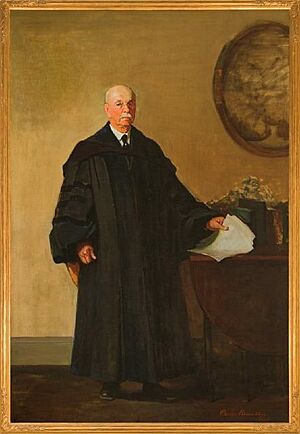Ira Remsen facts for kids
Quick facts for kids
Ira Remsen
|
|
|---|---|
 |
|
| Born | February 10, 1846 New York City, New York, U.S.
|
| Died | March 4, 1927 (aged 81) |
| Nationality | American |
| Alma mater | Columbia University College of Physicians and Surgeons University of Göttingen |
| Known for | Discovery of saccharin Founder, American Chemical Journal |
| Spouse(s) | Elisabeth Hilleard Mallory |
| Awards | Priestley Medal (1923) Willard Gibbs Award (1914) |
| Scientific career | |
| Fields | Chemistry |
| Institutions | University of Tübingen Williams College Johns Hopkins University |
| Doctoral advisor | Wilhelm Rudolph Fittig |
| Doctoral students | William Henry Emerson Charles Herty William A. Noyes Kotaro Shimomura |
| Signature | |
Ira Remsen (born February 10, 1846 – died March 4, 1927) was an American chemist. He is famous for discovering the artificial sweetener called saccharin. He found it with his research partner, Constantin Fahlberg. Remsen also became the second president of Johns Hopkins University.
He started the American Chemical Journal, a science magazine. He was its editor for 35 years, from 1879 to 1914.
Contents
Early Life and Education
Ira Remsen was born in New York City on February 10, 1846. His parents were James Vanderbelt Remsen and Rosanna Secor. He married Elisabeth Hilleard Mallory in 1875. They had two children together. Their son, Ira Mallory Remsen, later became a writer.
Remsen first earned a medical degree (M.D.) in 1865. But he decided to study chemistry instead. He went to Germany and earned his PhD in chemistry in 1870. He studied under a famous chemist named Wilhelm Rudolph Fittig.
A Career in Chemistry
After his studies in Germany, Remsen came back to the United States in 1872. He became a professor at Williams College. There, he wrote a popular textbook called Theoretical Chemistry.
His book and his good reputation caught the attention of Daniel Coit Gilman. Gilman invited Remsen to join the first group of professors at Johns Hopkins University. Remsen accepted and started the chemistry department there. He also ran his own laboratory. In 1879, he started the American Chemical Journal, which became a very important science publication.
The Discovery of Saccharin
In 1879, something exciting happened in Remsen's lab. A researcher named Fahlberg was working with Remsen. Fahlberg was studying chemicals from coal tar. One evening, after a long day in the lab, he was eating dinner. He noticed his rolls tasted sweet at first, then bitter. His wife didn't taste anything unusual. Fahlberg realized the taste was on his fingers.
The next day, he went back to the lab. He tasted the chemicals he had been working with. He found that a substance, created by oxidizing o-toluenesulfonamide, was the cause. He named this new substance saccharin. Remsen and Fahlberg published their discovery together in 1880.
Later, Remsen became very upset with Fahlberg. Fahlberg patented saccharin and claimed he discovered it all by himself. Remsen wasn't interested in making money from saccharin. But he was angry that Fahlberg didn't give him credit. Remsen believed that anything discovered in his lab should also credit him as the head of the lab. Fahlberg became rich from saccharin, while Remsen felt unfairly treated.
A Great Teacher
Throughout his time as a professor, Remsen was known as an excellent teacher. He had high expectations for his students. But he was also very patient with beginners. Many of his students learned how to teach well by watching his lectures. His lessons for new students were clear and easy to understand.
In 1879, he was chosen to be a member of the American Philosophical Society. This is a group that promotes useful knowledge.
Leading Johns Hopkins University
In 1901, Ira Remsen became the president of Johns Hopkins University. During his time as president, he helped the university grow. He started a new School of Engineering. He also helped make Johns Hopkins a leading research university. He brought many German laboratory techniques to the school. He also wrote several important chemistry textbooks.
In 1912, he retired as president due to health issues. He moved to Carmel, California. In 1923, he received the Priestley Medal. This is one of the highest awards in chemistry in the United States.
Death
Ira Remsen passed away on March 4, 1927, in Carmel-by-the-Sea, California. His ashes are buried behind a special plaque. This plaque is in the chemistry building at Johns Hopkins University. He is the only person buried on the university campus.
Legacy
After his death, the new chemistry building at Johns Hopkins was named Remsen Hall in his honor. It was finished in 1924.
His home in Baltimore was also recognized as important. It was added to the National Register of Historic Places and became a National Historic Landmark in 1975. Another building, Remsen Hall at Queens College, is also named after him.
Remsen Award
In 1946, to celebrate 100 years since Remsen's birth, a special award was created. The Maryland chapter of the American Chemical Society started the Remsen Award. This award honors chemists who have done amazing work. Many of the people who have received this award are very famous. Between 1950 and 1980, 16 Nobel laureates (winners of the Nobel Prize) received the Remsen Award.
- Some of the award recipients include
- 1946: Roger Adams
- 1950: Edward C. Kendall

- 1953: Edward L. Tatum

- 1957: Melvin Calvin

- 1961: Herbert C. Brown

- 1967: Marshall W. Nirenberg

- 1972: Charles H. Townes

- 1974: Elias J. Corey

- 1976: William N. Lipscomb Jr.

- 1980: Roald Hoffman

- 1989: K. Barry Sharpless

- 1991: Rudolph A. Marcus

- 2017: Robert H. Grubbs

See also
 In Spanish: Ira Remsen para niños
In Spanish: Ira Remsen para niños


